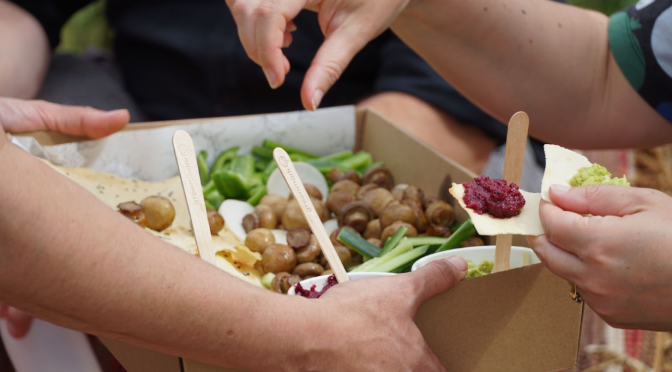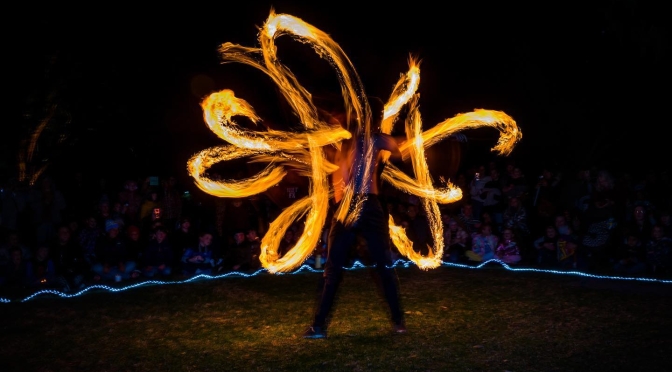Music and food make great mates, their charismatic combination creates the perfect context for friendships to flourish and where there’s one you will invariably find the other. From Vocal Noshes to music camps and choirs, there is nothing like a spot of music-making to work up an appetite and a gathering of like minded people chatting over a plateful of food after a session of singing or playing is a beautiful thing.
As Community Music Victoria is all about using music to facilitate connections and develop community networks we were very excited to learn from our Growing Community Music Murray Mallee team about what the good folks from Food Next Door Coop and Out of the Box Sunraysia are doing. Work that feels aligned with the values of our own organisation, and to hear about how everybody’s paths came to cross at the end of November.
Food Next Door Coop is a social enterprise scheme connecting newly arrived migrants with existing land owners who have soil space to share, and with vacant or under-utilised farmland in regional and rural areas of Victoria’s North West. It is a model that fosters inclusivity and generates the sharing of ideas in a literal cross-pollination of knowledge and culture, uniting people from diverse backgrounds with members of their new communities and providing them access to land and a way for them to support themselves on arrival in their new country, using farming practices from back home. Creating an avenue to a sustainable source of income and independence helps people to settle and strengthens community cohesion, while working the land in this way increases the number of small scale farms using sustainable practices beneficial to soil regeneration. The outcome is high quality, organic produce and a healthier landscape, both literally and figuratively, from the grass roots up.
Out of the Box offers local delivery of produce grown in the Sunraysia area using regenerative, organic farming practices and works closely with the Food Next Door Coop as a distribution outlet for their land sharing scheme. Bringing together customers, farmers, volunteers, and landholders, the onus is on keeping food miles down – everything is grown within a 150 kilometre radius of the city – and the boxes are sold on a subscription basis with a lucky dip of produce each week using prices set by the growers. It’s a beautiful way to develop and sustain the community, feeding the people of the township and enriching local community connections by bringing people together and strengthening the network, much in the same way as the community music groups listed on the CMVic database.
And, like music, food grown and shared within the community is not only nurturing, bringing people together at the source, it has a flow on effect. Events like farmers markets create avenues for the sharing and development of ideas and values and offer a springboard for friendships and tighter, healthier, more connected communities. They also provide wonderful performance spaces and opportunities for community choirs and music groups to share their work and spread the joy.

On November 26th 2022, Out of the Box Sunraysia celebrated its fifth birthday with an extravaganza of music, food and wine that was provided, made and shared by members of the community, including the CMVic Growing Community Music family. Catherine Threlfall led a drumming circle with people of all ages joining in and playing an assortment of percussion including djembes, triangles, and tambourines; there was a band with ukulele and fiddle players and dancing from the Barkindji Dancers, all accompanied by a sumptuous community feast made, of course, from locally sourced foods: Merbein Mushrooms and lentils, beetroot sourdough and even an orange almond birthday cake made with beautiful fresh navel oranges from the region.
Click here to watch a beautiful clip of the afternoons activities and listen to a moving speech made by Grant Hyam who runs Out of the Box in which he explains what being a part of it has brought to his life.
So if you are beginning the new year full of intentions to live well, joining a community music group or choir is a wonderful way to tick this box straight off the bat. A list of singing and music making opportunities can be accessed for free on the CMVic website. And if you are fortunate enough to live within coo-ee of Sunraysia and the Mallee, exploring the delicious work of the Out of the Box and Food Next Door Coop communities may support the turning over of any new leaves and lead to fresh growth and exciting opportunities as we take on 2023, together.

Written by Deb Carveth, CMVic Copy Editor, in collaboration with Kylie Livingstone, CMVic Growing Community Music Local Catalyst for Mildura, Sunraysia, Mallee
Video Credit: Luke Gange, Gange Productions. Photo Credits: Out of the Box Sunraysia.




































